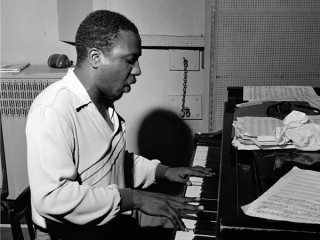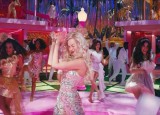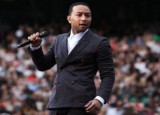
Thelonious Monk biography
Date of birth : 1917-10-10
Date of death : 1982-02-17
Birthplace : Rocky Mount, North Carolina, U.S.
Nationality : American
Category : Famous Figures
Last modified : 2011-12-14
Credited as : jazz pianist, composer, considered "one of the giants of American music"
2 votes so far
When Thelonious Monk began performing his music in the early 1940s, only a small circle of New York's brightest jazz musicians could appreciate its uniqueness. His melodies were angular, his harmonies full of jarring clusters, and he used both notes and the absence of notes in unexpected ways. He flattened his fingers when he played the piano and used his elbows from time to time to get the sound he wanted. Critics and peers took these as signs of incompetency, treating his music with "puzzled dismissal as deliberately eccentric," Jazz Journal noted. "To them, Monk apparently had ideas, but it took fleshier players like pianist Bud Powell to execute them properly." The debate over his talent and skill continued as the years passed, but Monk eventually earned a strong following. By the time of his death in 1982, he was widely acknowledged as a founding father of modern jazz.
The New York Post once called Monk "one of jazz's great eccentrics." During concerts and recording sessions he would rise from his bench every so often and lunge into a dance, emphasizing the rhythm he wanted from his band members with his 200-pound frame. With his strange hats, bamboo-framed sunglasses, and goatee, he became an obvious subject for Sunday supplement caricatures. There was also the way he talked: He and his peers were known for popularizing such expressions as "groovy," "you dig, man," and "cool, baby." Most Americans, however, first heard of Monk in the early 1950s when he was arrested for allegedly possessing drugs--for Monk, one of several instances of legal harassment that would create severe obstacles to his work.
Thelonious Sphere Monk was born on October 10, 1917, in Rocky Mount, North Carolina. The first music he heard was from a player piano that his family owned. At the age of five or six he began picking out melodies on the piano and taught himself to read music by looking over his sister's shoulder as she took lessons. About a year later the family moved to New York City. Monk's father became ill soon afterward and returned to the South, leaving the boy's mother to raise him and his brother and sister by herself. She actively encouraged her young son's interest in music. Though the family budget was tight, Monk's mother managed to buy a baby grand Steinway; when Monk turned 11 she began paying for weekly lessons. Even at that age it was clear that the instrument was part of his destiny. "If anybody sat down and played the piano," Monk recalled in Crescendo International, "I would just stand there and watch 'em all the time."
As a boy Monk received rigorous gospel training, accompanying the Baptist choir in which his mother sang and playing piano and organ during church services. At the same time, he was becoming initiated into the world of jazz; near his home were several jazz clubs as well as the home of the great Harlem stride pianist James P. Johnson, from whom Monk learned a great deal. By age l3 he was playing in a local bar and grill with a trio. A year later he began playing at "rent" parties--thrown to raise money for rent--which meant holding his own among pianists who would each perform marathon displays of virtuosity. Monk gained further distinction at the Apollo Theater's famous weekly amateur contests, which he won so often that he was banned from the event. At 16 he left school to travel with an evangelical faith healer and preacher for a year-long tour that indoctrinated him into the subtleties of rhythm and blues accompaniment.
Upon returning to New York, Monk began playing non-union jobs. In 1939 he put his first group together. An important gig came in the early 1940s, when Monk was hired as house pianist at a club called Minton's. It was a time of dramatic innovation in jazz. Swing, the music of older jazzmen, had become inadequate for postwar society. In its place, a faster, more complex style was developing. The practitioners of this new music, called bebop, created it virtually on the spot, "in jam sessions and discussions that stretched past the far side of midnight," Keyboard explained. "According to jazz folklore, this activity centered on Minton's, and as the house pianist there, Monk was at the eye of what would become the bebop hurricane."
Yet while Monk was pivotal in inspiring bebop, his own music had few ties to any particular movement. Monk was an undisputed and independent original, and the proof was in his compositions. "More than anyone else in the Minton's crowd, Monk showed a knack for writing," Keyboard remarked. "Years before his piano work would be taken seriously, he would be known for his composing. In fact, most of the classic Monk tunes, such as 'Blue Monk,' 'Epistrophy,' and ''Round Midnight,' were written during his gig at Minton's or before 1951."
As the 1940s progressed and bebop became more and more the rage, Monk's career declined. In 1951 he was arrested with Bud Powell on a questionable charge of narcotics possession. Not only was he confined for 60 days in prison, but the New York State Liquor Authority rescinded his cabaret card, without which he could not play local club dates. For several years he survived only with the help of his good friend and patron the Baroness Nica de Koenigswarter.
By the mid-1950s, though, Monk's fortune took a turn for the better. In 1954 he gave a series of concerts in Paris and cut his first solo album, Pure Monk (now out of print). A year later he began recording for the Riverside label. His following grew, and as Keyboard reported, his mystique grew as well. "Program notes for the Berkshire Music Barn Jazz Concert in 1955 read, 'Monk is the Greto Garbo of jazz, and his appearance at any piano is regarded as a major event by serious followers of jazz.'" In 1957 Monk opened an engagement at New York's Five Spot, leading a powerful quartet with then-jazz newcomer John Coltrane on saxophone. The eight-month gig was pivotal for Monk, who "found himself at the center of a cult," according to Keyboard. "Audiences lined up to see his unpredictable performances, his quirky, quietly ecstatic dances during horn solos, his wanderings through the room." Several masterful discs he recorded for Riverside in the late 1950s--Brilliant Corners, Thelonious Himself, and Monk with Coltrane-- increased his notoriety, rendering him "the most acclaimed and controversial jazz improviser of the late 1950s almost overnight." It didn't either hurt that both Coltrane and saxophonist Sonny Rollins were acknowledging him as their guru.
The strange behavior that Monk displayed in public sometimes got him into trouble. A New York Times review of the 1989 Monk documentary Straight, No Chaser commented on his temperament, revealing that the great pianist was "acutely sensitive and moody and perhaps a manic-depressive.... Illness eventually made it impossible for him to perform." In 1958 he was arrested for disturbing the peace and his cabaret license was revoked a second time. Forced to take out-of-town gigs, he was separated from his two main sources of stability--New York City and his wife Nellie--and his eccentricities thus intensified. During one episode in 1959 in Boston, state police picked him up and took him to the Grafton State Hospital, where he was held for a week. Around 1960 his cabaret club card was restored and he returned to playing New York clubs. Now when he played a gig his wife accompanied him.
Toward the end of the 1950s Monk began to receive the prestige he had long deserved. His late fifties recordings on Riverside fared so well that in 1962 he was offered a contract from Columbia. As a performer he was equally successful, commanding $2,000 for week-long engagements with his band and $1,000 for single performances. In 1964 Monk appeared on the cover of Time magazine--an extremely rare honor for a jazz artist.
In the early 1970s, Monk made some solo and trio recordings for Black Lion in London and played a few concerts. But, beginning in the mid-1970s he isolated himself from his friends and colleagues, spending his final years at the home of the Baroness de Koenigswarter in Weehawken, New Jersey. After playing a concert at Carnegie Hall in March of 1976, Monk was too weak physically to make further appearances. He died on February 17, 1982, after suffering a massive stroke.
There was "a Monk fever in the jazz world" for at least two years before the pianist's death, observed Village Voice contributor Stanley Crouch. But, as record producer Orrin Keepnews observed in Keyboard, performing Monk's music is no easy feat. His "material can be basically divided into two categories: difficult and impossible." Monk's eccentric piano technique also raised eyebrows among music critics. Concerning those who criticized his technique, Monk told Crescendo International, "I guess these people are surprised when they hear certain things that I've done on records. They must feel awful silly about saying I don't have no technique. Because I know you've heard me make some fast runs. You can dig how stupid the statement is."
Looking back on his career, Monk told Crescendo International, "As for the hard times I've had--I've never been jealous of any musician, or anything. Musicians and other people have told lies on me, sure, and it has kept me from jobs for awhile.... But it didn't bother me. I kept on making it--recording and doing what I'm doing, and thinking. While they were talking I was thinking music and still trying to play."
Discography
Blue Note Records (1948–1952):
-Genius of Modern Music: Volume 1 (1947 Blue Note recordings)
-Genius of Modern Music: Volume 2 (1951–1952 Blue Note recordings)
Prestige Records (1952–1954)
-Thelonious Monk Trio (Prestige 7027), 1952-4
-Monk (Prestige 7053) recorded 1953-4
-Thelonious Monk and Sonny Rollins (Prestige 7075), recorded 1953-4
Riverside Records (1955–1961)
-Thelonious Monk plays the Music of Duke Ellington (1955)
-The Unique Thelonious Monk (1955)
-Brilliant Corners (1956 recording with Sonny Rollins and Clark Terry)
-Thelonious Himself (1957)
-Monk's Music (1957)
-Mulligan Meets Monk (1957, with Gerry Mulligan)
-Thelonious in Action and Misterioso (1958, live at the Five Spot with Johnny Griffin)
-The Thelonious Monk Orchestra at Town Hall (1959, Charlie Rouse joined the band then)
-5 by Monk by 5 (1959)
-Thelonious Alone in San Francisco (1959)
-Thelonious Monk at the Blackhawk (1960, with Charlie Rouse)
-Thelonious Monk with John Coltrane (1957 recordings, 1961 issue) - Inducted into the Grammy Hall of Fame in 2007.
-Monk in France (recorded in 1961)
-Thelonious Monk in Italy (recorded 1961)
-Thelonious Monk and the Jazz Giants (1987)
-Thelonious Monk Quartet Live at the Five Spot: Discovery! (with Coltrane recorded 1958, released in 1993 on Blue Note)
-Thelonious Monk Quartet with John Coltrane at Carnegie Hall (1957, released 2005 on Blue Note.)
-The Complete 1957 Riverside Recordings (2006 collection of the 1957 studio recordings with Coltrane)
Columbia Records (1962–1968)
-Monk's Dream (1963)
-Criss Cross (1963)
-Monk in Tokyo (1963)
-Miles & Monk at Newport (1963, with unrelated 1958 Miles Davis performance)
-Big Band and Quartet in Concert (1963)
-It's Monk's Time (1964)
-Monk (1964)
-Solo Monk (1964)
-Live at the It Club (1964)
-Live at the Jazz Workshop (1964)
-Straight, No Chaser (1966)
-Monk's Miracles (1966)
-Underground (1967)
-Monk's Blues (1968)
















